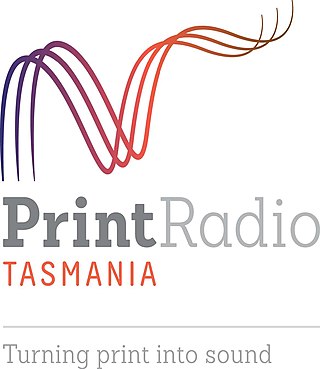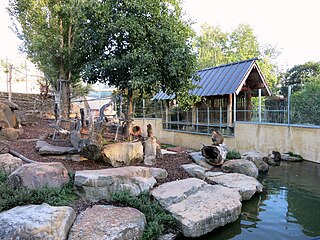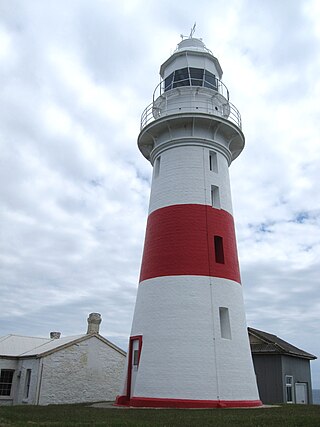
Launceston is a city in the north of Tasmania, Australia, at the confluence of the North Esk and South Esk rivers where they become the Tamar River (kanamaluka). As of 2021, the Launceston urban area has a population of 90,953. Launceston is the second most populous city in Tasmania after the state capital, Hobart. As of 2020, Launceston is the 18th largest city in Australia. Launceston is the fifth-largest inland city and the ninth-largest non-capital city in Australia. Launceston is regarded as the most livable regional city, and was one of the most popular regional cities to move to in Australia from 2020 to 2021. Launceston was named Australian Town of the Year in 2022.

Beaconsfield is a former gold mining town near the Tamar River, in the north-east of Tasmania, Australia. It lies 40 kilometres north of Launceston on the West Tamar Highway. It is a rural and residential locality in the local government areas (LGA) of West Tamar and Latrobe in the Launceston and North-west and west LGA regions of Tasmania. The 2016 census has a population of 1298 for the state suburb of Beaconsfield.

Boag's Brewery is an Australian brewery company founded in 1883 by James Boag and his son, also named James, in Launceston, Tasmania, Australia. It is now owned by Lion, a Trans-Tasman subsidiary company of Japanese beverage conglomerate, Kirin. All of the company's beers are produced in Launceston.
The Division of Bass is an Australian electoral division in Tasmania.

The Australian Maritime College (AMC) is a tertiary education institution based in Launceston, Tasmania, established by the Maritime College Act 1978 (Cth). Tertiary education is provided and organised by the University of Tasmania (UTAS) as the Australian Maritime College at the University of Tasmania (AMC@UTAS). However the college's educational curriculum is governed by the independent AMC Board. The AMC is Australia's national centre for maritime education, training and research. It has two campuses located within 50 kilometres (31 mi) of each other in Northern Tasmania, each with different facilities and residence.

The Tamar Conservation Area covers approximately 4,633 ha on the Tamar River estuary in Tasmania. It includes the Tamar Island Wetlands Reserve and a stretches through the upper part of the Tamar Estuary from St Leonards to the Batman Bridge. It is a popular area for birdwatching and is about 15 minutes drive from Launceston. There are approximately 3.2 km of walking tracks at the wetlands including a boardwalk for easy access to the island.

Launceston Christian School (Inc.) is a private, co-educational day school based in Riverside, Launceston, Tasmania, Australia. Established in 1976, the school is operated and controlled by an Association. Launceston Christian School caters for around 630 students from Kindergarten through to Year 12. The principal is Stuart Kent.

Trevallyn is a residential locality in the local government areas (LGAs) of Launceston (25%) and West Tamar (75%) in the Launceston LGA region of Tasmania. The locality is about 3 kilometres (1.9 mi) west of the city of Launceston. The 2016 census recorded a population of 4562 for the state suburb of Trevallyn. It is a suburb of Launceston.
The Queen Victoria Museum and Art Gallery (QVMAG) is a museum located in Launceston, Tasmania, Australia. The QVMAG is the largest museum in Australia not located in a capital city.

The West Tamar Highway is a highway in Tasmania, Australia. It covers the western edge of the Tamar River, from Launceston to the beach town of Greens Beach.
The East Tamar Highway is a highway in Tasmania, Australia. It covers the eastern edge of the Tamar River, from Launceston to the lighthouse at Low Head.

Print Radio Tasmania is a radio station based in Hobart, Tasmania. It is a reading and information service for those persons unable to read or easily access information in print. The station is run and operated by volunteers.

Launceston City Park is a park in Launceston, Tasmania, Australia. Established in the 1820s by the Launceston Horticultural Society and handed over to the Launceston City Council in 1863. It is now an important part of cultural life in Launceston and also a heritage park.
Bell Bay is an industrial centre and port located on the eastern shore of the Tamar River, in northern Tasmania, Australia. It lies just south of George Town. In the year ended June 2021, 3.6 million tonnes of exports and imports passed through Bell Bay.

Country Club Tasmania is a casino in Launceston, Tasmania, owned by Federal Hotels. It is Tasmania's second casino. It is also used for a variety of local events and is home to an 18-hole golf course. Targa Tasmania uses the casino as a starting point for the race.

Low Head Lighthouse is in Low Head, Tasmania, about 7 kilometres (4.3 mi) north of George Town on the east side of the mouth of the Tamar River. It was the third lighthouse to be constructed in Australia, and it is also Australia's oldest continuously used pilot station. This light is now unmanned and automated.

The Tamar Wetlands Important Bird Area is a linear stretch of wetland habitat, with an area of 51 km2, extending along the upper half of the estuarine Tamar River in northern Tasmania, Australia.

St Andrew's Kirk, Launceston, is a Presbyterian church located on St John Street in Launceston, Tasmania, Australia, serving the Presbytery of Bass. It was the second Presbyterian church to be built in the city of Launceston following the Scotch National Church on Charles Street.

Grubb's Tramway was a partially completed, private logging tram line in Tasmania from the junction of the Launceston-George Town Road at the Tamar River near Mowbray to a saw mill at Pipers River.

Christ Church and Milton Hall are adjacent 19th-century buildings with significance in the early religious and secular history of Launceston, Tasmania. Both buildings are located on Frederick Street, near Prince's Square.















